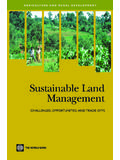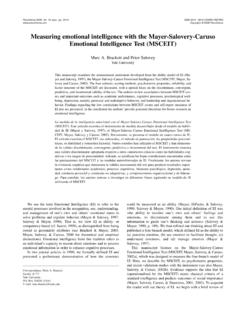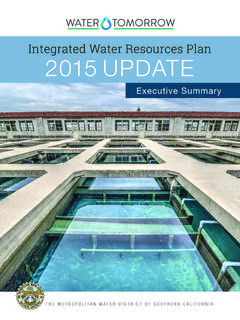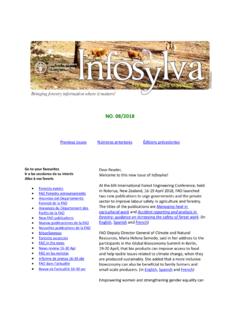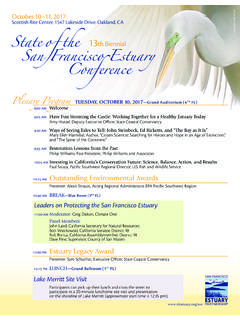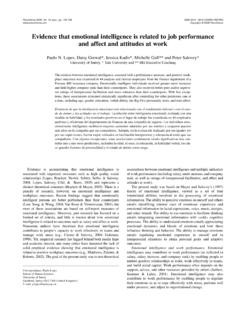Transcription of Global guidelines for the restoration of degraded …
1 ISSN 0258-6150 Global guidelines for the restoration of degraded forests and landscapes in drylandsGlobal guidelines for the restoration of degraded forests and landscapes in drylandsBuilding resilience and benefiting livelihoodsBuilding resilience and benefiting livelihoodsDrylands cover nearly half of the earth s land surface and are home to one-third of the Global population. They face extraordinary challenges, including those posed by desertification, biodiversity loss, poverty, food insecurity and climate change. Up to 20 percent of the world s drylands are degraded , and people living there are often locked into a vicious circle of poverty, unsustainable practices and environmental degradation. It is clear that serious efforts are needed to arrest dryland degradation and restore degraded lands, and the simple but urgent aim of these guidelines is to support such effortsIt is the first time that Global guidelines on dryland restoration are made available.
2 These guidelines target two main groups policymakers and other decision-makers, and practitioners because both have the power to bring about positive change. While they should be tailored to suit regional and local contexts, they present the essential components for the design, implementation and sustainability of restoration initiatives that can help build ecological and social resilience and generate benefits for local illustrated by the rich case studies provided, the guidelines involve a vast range of actions, from on-the-ground activities such as habitat protection, assisted natural regeneration, sand-dune stabilization and planting, to policy improvements, provision of financial incentives, capacity development, and continuous monitoring and learning.
3 Moreover, they show that restoration needs to be considered across the entire market value chain, from seed to end-product, as well as at the landscape level, including the mosaic of land uses, needs and expectations of interest FORESTRY PAPER175 Global guidelines for the restoration of degraded forests and landscapes in drylands Building resilience and benefiting livelihoodsFAOFORESTRYPAPER175 REPUBLIC OF TURKEYPRIME MINISTRYT urkish Cooperation and Coordination AgencyThis document has been printed with the financial assistance of the European Union. The views expressed herein can in no way be taken to reflect the official opinion of the European guidelines for the restoration of degraded forests and landscapes in drylands - Building resilience and benefiting livelihoodsI5036E/1 978-92-5-108912-5978 9255 089121 ISSN 0258-6150 Cover photo: Soil preparation for planting in Tera, Great Green Wall, Niger ( Moctar Sacande) Global guidelines for the restoration of degraded forests and landscapes in drylandsBuilding resilience and benefiting livelihoodsFOOD AND AGRICULTURE ORGANIZATION OF THE UNITED NATIONSRome, 2015 FAOFORESTRYPAPER175 FAO.
4 2015. Global guidelines for the restoration of degraded forests and landscapes in drylands: building resilience and benefiting livelihoods. Forestry Paper No. 175. Rome, Food and Agriculture Organization of the United designations employed and the presentation of material in this information product do not imply the expression of any opinion whatsoever on the part of the Food and Agriculture Organization of the United Nations (FAO) concerning the legal or development status of any country, territory, city or area or of its authorities, or concerning the delimitation of its frontiers or boundaries. The mention of specific companies or products of manufacturers, whether or not these have been patented, does not imply that these have been endorsed or recommended by FAO in preference to others of a similar nature that are not views expressed in this information product are those of the author(s) and do not necessarily reflect the views or policies of 978-92-5-108912-5 FAO, 2015 FAO encourages the use, reproduction and dissemination of material in this information product.
5 Except where otherwise indicated, material may be copied, downloaded and printed for private study, research and teaching purposes, or for use in non-commercial products or services, provided that appropriate acknowledgement of FAO as the source and copyright holder is given and that FAO s endorsement of users views, products or services is not implied in any requests for translation and adaptation rights, and for resale and other commercial use rights should be made via or addressed to information products are available on the FAO website ( ) and can be purchased through viiAcknowledgements ixPreface xiiAcronyms and abbreviations xivExecutive summary xvi1 Introduction Why guidelines ?
6 The process The target audience The structure 32 Drylands and the benefits of restoration What are drylands? The importance of forests and trees in drylands Key challenges in drylands restoration in drylands 133 guidelines for policymakers and other decision-makers: establishing a strong enabling environment Enabling and investing in assessment and monitoring Addressing the drivers of land degradation by engaging in cross-sectoral dialogue and planning at the landscape scale Enabling and investing in capacity assessment and development to respond to restoration needs and challenges Supporting approaches and strategies for improving the supply of, and access to, plant reproductive material for restoration Improving the governance and policy framework Creating the right conditions for investment and resource mobilization for restoration Knowledge, research, learning and experimenting 384 guidelines for practitioners.
7 restoration in action Planning and choosing the most cost-effective restoration strategy Protecting and managing drylands Assisted natural regeneration Planting 51iv5 Monitoring and evaluation Integrating monitoring as part of adaptive management Starting monitoring during the planning phase Involving multiple stakeholders in monitoring Monitoring, evaluating, and sharing experiences on dryland restoration 626 Case studies Cross-sectoral work to mobilize trade as an incentive for investment in the gum arabic sector Mainstreaming forest landscape restoration in the policy framework of Tanzania Making change happen: what can governments do to strengthen forest producer organizations?
8 Hill resource management societies in Haryana state, India: a successful joint forest management approach to common-property resources Participatory technology development: the V-shaped microcatchment for olive groves in the Syrian Arab Republic The restoration of forest landscapes in the southern Caucasus Mediterranean mosaics: strengthening resilience in the Shouf Biosphere Reserve, Lebanon Addressing landscape restoration through integrated watershed management in the Bagmati River Basin, Nepal Anatolia watershed rehabilitation project, Turkey Afforestation of the dried Aral Sea floor to combat desertification and climate change in Uzbekistan Fighting sand encroachment in Mauritania The Ecograze grazing management system in Australia Planning for fire-smart landscapes in the Mediterranean.
9 Lebanon s national forest fire management strategy Community-managed exclosures in the Tigray, Ethiopia The farmer-managed restoration of agroforestry parklands in southeastern Niger Habitat restoration and the sustainable use of southern Peruvian dry forests The Millennium Seed Bank Partnership Working for water: job creation, watershed management and the control of invasive plant species in the Western Cape Province of South Africa Combating desertification in the Horqin Sandy Land through integrated afforestation, Inner Mongolia, China Applied research for the ecological restoration of desertification-prone areas in the Albatera watershed, Valencia, Spain Farmer-managed soil and water conservation in the Central Plateau of Burkina Faso degraded arid land restoration for afforestation and agrosilvopastoral production using the Vallerani system in Gorom Gorom, Burkina Faso restoration using bench terrace systems in drylands.
10 The Colca Valley of Peru The use of treated wastewater for greening the desert: Algeria and Egypt restoration of a degraded forest and its conversion into a wildlife safari reserve: Bandia, Senegal restoration in the China Loess Plateau Innovative forest restoration techniques in semi-arid conditions in northeast Spain: soil conditioners and mulching 1147 The way forward 117 Glossary 121 References, further reading, tools and guidelines , other case studies and websites 127 BoxesThe TIKA FAO partnership The international policy framework for restoration Tools for situation assessment in dryland forests and landscapes The landscape approach What are multisectoral platforms?










